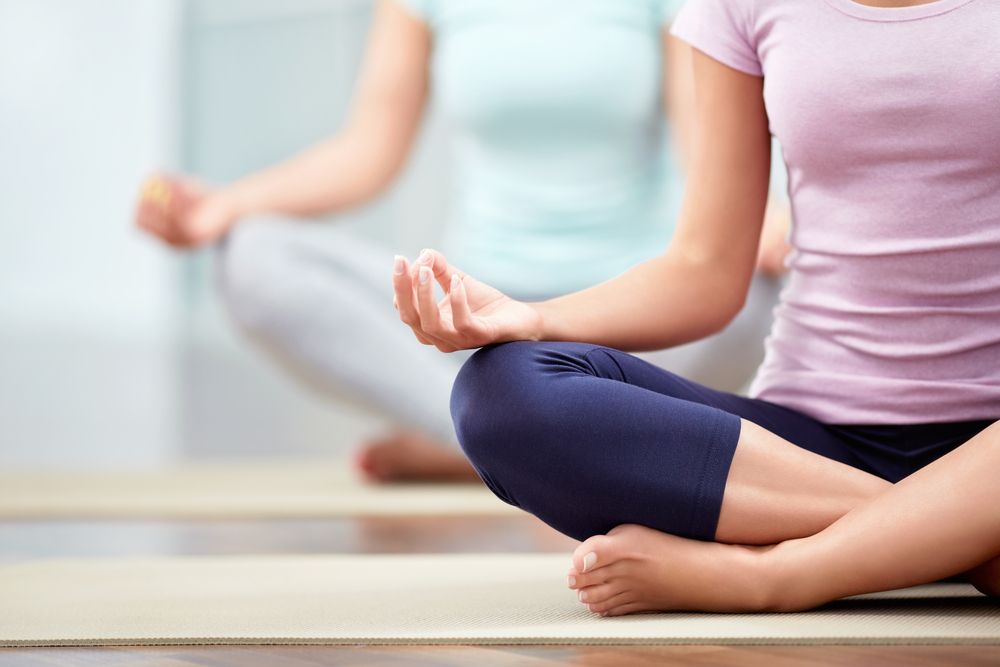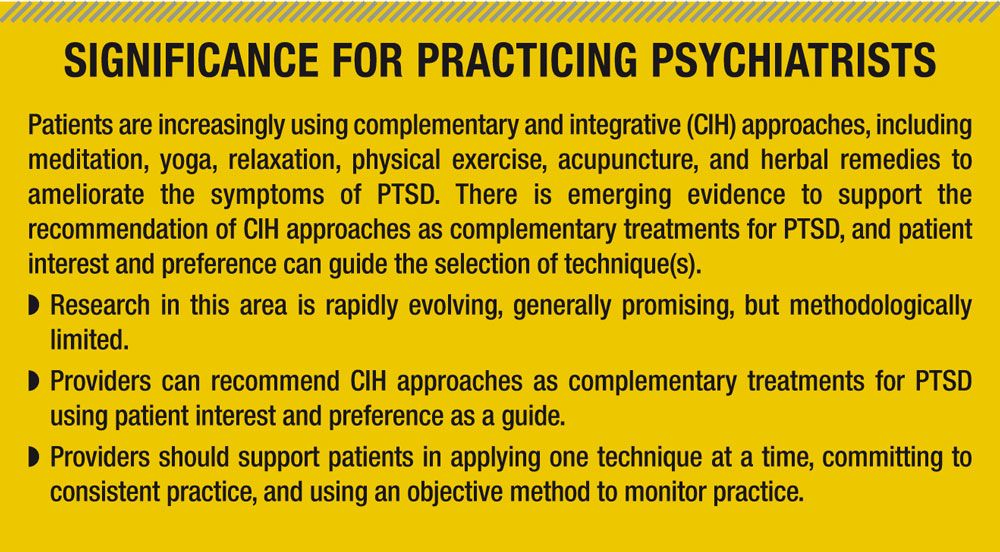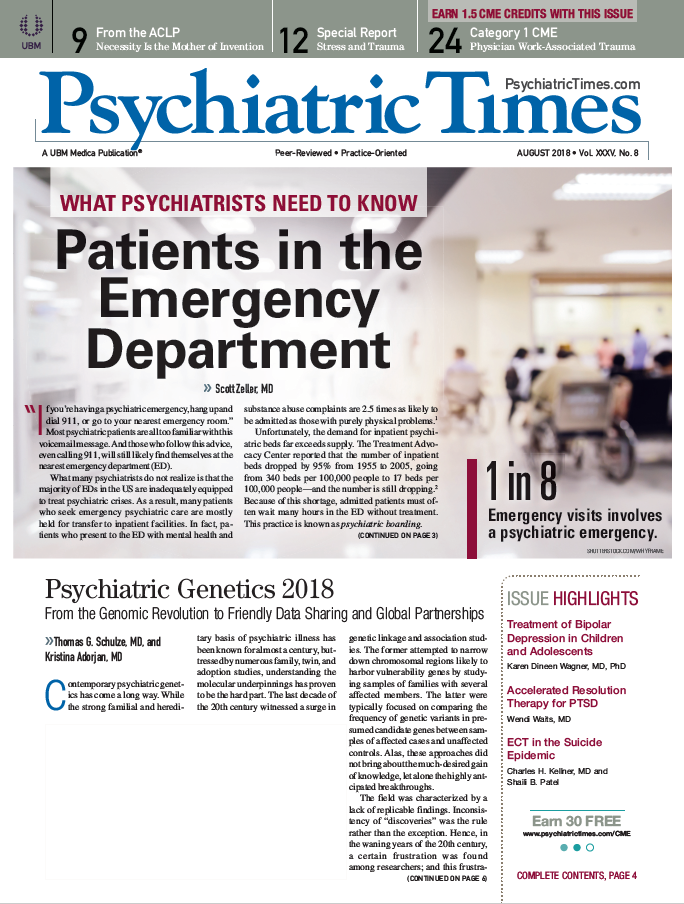Publication
Article
Psychiatric Times
Complementary and Integrative Health Approaches for PTSD
Although efficacious treatments for PTSD have been established, many individuals remain symptomatic after treatment or never seek empirically supported therapies. This is where complementary and alternative medicine comes in.
LuckyImages/Shutterstock.com

SIGNIFICANCE FOR PRACTICING PSYCHIATRISTS

TABLE. Overview of CIH approaches for PTSD

In recent years, we have witnessed growing interest in complementary and integrative health (CIH), which involves the incorporation of strategies that currently fall outside of Western medicine into care with the aim of improving wellness as opposed to simply mitigating symptoms. “Complementary” refers to the application of these treatments in conjunction with standard care, while “alternative” is used when these practices replace conventional treatment. “Integrative” is a term used to refer to the combination of traditional and non-traditional approaches. The National Center for Complementary and Integrative Health (NCCIH) reports that many Americans (~30% of adults) use CIH approaches, citing “general wellness or disease prevention” as the most common reason for use.1 Additional commonly endorsed goals of CIH use include to “feel better emotionally” or to “treat a specific medical or mental health condition.”
Although efficacious treatments for PTSD have been established, many individuals remain symptomatic after treatment or never seek empirically supported therapies. The two FDA-approved medications for the treatment of PTSD (sertraline and paroxetine) on average confer minimal to modest benefits that are not generally maintained over time. Furthermore, the development of new pharmacological treatments for PTSD has been described as stagnant.2 Hence, there is a need for approaches to augment current best practices.
Individuals with PTSD are increasingly seeking CIH (see the Table for summary of CIH approaches); in a 2012 survey, 39% of individuals with PTSD reported using CIH, with meditation and relaxation being the most commonly employed modalities.3 Despite the increasing popularity of CIH, a 2011 systematic review identified only seven randomized controlled trials (RCTs) of CIH for PTSD; the studies were generally preliminary, underpowered, and methodologically limited. Although many researchers continue to work actively in this area, methodological concerns, such as small sample sizes, lack of active comparators and non-randomized designs, continue to limit the conclusions that can be drawn. As a result, there is no definitive evidence about the use of CIH approaches for the treatment of PTSD or about the selection of one approach over another. Although many studies have demonstrated the potential usefulness of CIH, it would be premature to recommend the use of CIH approaches as front-line treatments for PTSD.
Meditation
Open-monitoring meditation. Open-monitoring meditation involves paying attention to thoughts, feelings, and sensations as they arise, without judgment. Mindfulness, a well-known example of this practice, involves present-focused attention on what is happening in the moment with non-judgmental acceptance of the experience. Mindfulness offers a way to increase awareness and acceptance of difficult experiences. Several preliminary studies and one RCT have demonstrated initial promise of mindfulness-based interventions, such as mindfulness-based stress reduction, in reducing PTSD symptoms.4-6
Concentrative meditation. Concentrative meditation, such as transcendental meditation (TM) or mantra meditation, involves focused attention on an object, word, image, or breath. Initial studies have demonstrated the feasibility of mantra meditation and TM for individuals with PTSD.7,8 One application, the Mantram Repetition Program (MRP), involves focus on repetition of a spiritually meaningful word or phrase (eg, Om, Ave Maria, Shalom); when attention wanders, it is returned to the word or phrase, without judgment. One RCT demonstrated added benefit of MRP when added to treatment as usual, and additional work is underway to evaluate MRP compared with an active control.9
Mantra meditation may be particularly helpful for reducing physiological arousal, which has potential clinical utility in that individuals with prominent hyperarousal symptoms tend to show less overall symptom improvement over time than those without prominent hyperarousal symptoms.10,11 A recently completed study that compared TM, prolonged exposure therapy, and psychoeducation will likely contribute to our understanding of the relative benefits of concentrative meditation.12
Contemplative meditation. Contemplative practices involve focusing ples that have been applied to PTSD include compassion meditation, such as Cognitively Based Compassion Training®, which focuses on the wish that others be free from suffering, and loving-kindness meditation, which involves the repetition of positive intentions for self and others (eg, “may all beings be happy and free”). Compassion meditation has been associated with increases in positive emotion and social connectedness in non-clinical samples.13,14 Open trials suggest the feasibility and potential clinical utility of these approaches for veterans with PTSD.15,16 Work is ongoing in our laboratory and elsewhere to examine the efficacy of these approaches.
CASE VIGNETTES
Mr R, aged 55 years, sought treatment for PTSD symptoms, including hypervigilance, insomnia, exaggerated startle response, and irritability. He agreed to engage in a manualized treatment protocol that included exposure, cognitive restructuring, and experiential processing of trauma-related emotions and beliefs. Mr R was offered training and practice in mindful breathing as an adjunct to his trauma-focused psychotherapy.
Mr R did not initially have a positive response to the mindful breathing exercises, stating that he “didn’t get it” and found it “corny.” Nonetheless, he was encouraged to use this practice to help shift his perspective and engage in the present. After about 3 weeks of practice, he stated that “it started to click,” and after 6 weeks of practice, he stated that it helped him feel more relaxed and less irritable. After 12 weeks of practice, Mr R reported improvements in hyperarousal symptoms and was able to respond to trauma reminders in a more functional way due to his ability to shift perspectives.
Mr L is a veteran with PTSD and chronic pain, who joined our compassion meditation program (Cognitively Based Compassion Training®) as an adjunct to his pharmacologic treatment. He had symptoms of avoidance related to both conditions and reported irritability. At the start of training, he reported some struggles with learning meditation, finding it difficult to maintain focus on the breath and becoming frustrated when his attention was drawn away. He persisted with the practice, however, and was particularly compelled by the contemplative practice in the latter half of the group. Although his PTSD symptom scores reduced meaningfully, his primary provider was most struck by the difference in his appearance after he completed the group. Previously somewhat disheveled and presenting an angry demeanor, he was dressing and grooming himself more neatly. He had realized that he had been conveying a message to others to “stay away,” and wanted now to be seen as open to engaging with others.
Recommendations. Meditation is readily accessible, deliverable in a group format, typically well-tolerated by individuals with PTSD, and has low risk of adverse effects. Patient preference may dictate the approach. There is no indication that meditation would interfere with standard treatment; instead, there is initial evidence that meditation-based approaches may augment usual care.9 Thus, we recommend encouraging meditation practice in addition to standard care as consistent with current treatment guidelines.
Yoga
Yoga typically consists of physical movements or postural sequences, intentional regulation of breathing, and focused attention. Yoga may help to reduce physiological arousal, increase a subjective sense of calm, and increase tolerance of and non-reactivity to internal experiences. Study findings suggest benefits of yoga among individuals with PTSD.17,18
Recommendations. Yoga is acceptable, feasible, and low-risk; yoga can be recommended as a complementary approach to other evidence-based treatments. It may be helpful to direct individuals with PTSD to teachers who are familiar with trauma-sensitive yoga. Macy and colleagues19 offer the following guidelines to providers who recommend yoga to their patients:
• Individuals should commit to consistent practice for at least 2 to 3 months.
• Meditation should be a component of yoga practice.
• Formal classes provided by a certified yoga instructor are preferred to independent practice.
• All individuals should consult with a physician prior to beginning the practice of yoga to discuss the unlikely, but possible, physical risks associated with yoga.
Other CIH approaches
Acupuncture. For a summary of the conceptual rationale and proposed mechanisms for the potential efficacy of acupuncture for PTSD, see the review by Hollifield and colleagues.20 Several preliminary studies found promising evidence for the efficacy of acupuncture for treating PTSD; however, firm conclusions regarding the effectiveness of acupuncture cannot be made.21,22
Relaxation. Relaxation techniques, such as diaphragmatic breathing and progressive relaxation, are often taught in cognitive and behavioral therapies for PTSD and may promote meaningful engagement in trauma-focused psychotherapy. Some studies have found evidence for the benefits of relaxation training for PTSD, however other studies showed minimal clinical benefit from relaxation training.23,24 Relaxation training alone is unlikely to be sufficient to address symptoms of PTSD.
Physical exercise. One initial review suggests that physical exercise is inversely related to PTSD symptoms; another preliminary study found that aerobic exercise before PE augmented treatment gains.25,26 Despite the paucity of evidence, it is reasonable to believe that physical exercise may confer benefits to individuals with PTSD, including increased positive affect, improved sleep quality, reduced social isolation/withdrawal, and physiological regulation. Physical exercise can certainly be recommended to complement standard care.
Herbal remedies. Herbal remedies, such as kava and St. John’s wort, may be helpful in treating symptoms that commonly accompany PTSD, such as depressive and anxiety symptoms. In some cases, life-threatening drug interactions have been reported with the use of St. John’s wort.27 Therefore, patients should be cautioned against using herbal treatments combination with alcohol or other medications.
Conclusions
CIH is widely requested and used by patients for a variety of complaints, including managing PTSD symptoms. Not all CIH approaches appear equally promising in the treatment of PTSD, although research in this area is rapidly evolving. Given the relative lack of rigorous, well-designed RCTs to evaluate the efficacy, safety, and specificity of CIH approaches, CIH appears best applied as an adjunct to other treatments or for individuals who initially refuse other evidence-based approaches.
CIH approaches can be reasonably recommended as complementary treatments for individuals with PTSD; there is no evidence that the techniques are harmful aside from the caveat about herbal remedies. Clinicians are encouraged to take an empirical approach to recommending these techniques: try one approach at a time, recommend consistent practice, and use an objective method to monitor response. Given that there is no evidence to suggest that one CIH approach is superior to another, patient interest and preference can guide these decisions. Many individuals will need guidance and training to implement these approaches, so clinicians should be knowledgeable and have a conceptual understanding of these approaches to provide support for patients learning new techniques.
Disclosures:
Dr Malaktaris is a Postdoctoral Fellow with the Center of Excellence for Stress and Mental Health, VA San Diego Healthcare System, and the University of California, San Diego, Department of Psychiatry. Dr Lang is Acting Director of the Center of Excellence for Stress and Mental Health, VA San Diego Healthcare System, and a Professor in the Departments of Psychiatry and Family Medicine & Public Health at the University of California, San Diego. The authors report no conflicts of interest concerning the subject matter of this article.
References:
1. Stussman BJ, Black LI, Barnes PM, et al. Wellness-Related Use of Common Complementary Health Approaches Among Adults: United States, 2012. Washington, DC: National Center for Health Statistics; 2015: 1-12.
2. Krystal JH, Davis LL, Neylan TC, et al. It is time to address the crisis in the pharmacotherapy of posttraumatic stress disorder: a consensus statement of the PTSD Psychopharmacology Working Group. Biol Psychiatry. 2017;82:e51-e59.
3. Libby DJ, Pilver CE, Desai R. Complementary and alternative medicine in VA specialized PTSD treatment programs. Psychiatr Serv. 2012;63:1134-1136.
4. Kearney DJ, McDermott K, Malte C, et al. Association of participation in a mindfulness program with measures of PTSD, depression and quality of life in a veteran sample. J Clin Psychol. 2012;68,101-116.
5. Niles BL, Klunk-Gillis J, Ryngala DJ, et al. Comparing mindfulness and psychoeducation treatments for combat-related PTSD using a telehealth approach. Psychol Trauma. 2012;4:538-547.
6. Polusny MA, Erbes CR, Thuras P, et al. Mindfulness-based stress reduction for posttraumatic stress disorder among veterans: a randomized clinical trial. JAMA. 2015;314:456-465.
7. Bormann JE, Thorp S, Wetherell JL, Golshan S. A spiritually based group intervention for combat veterans with posttraumatic stress disorder: feasibility study. J Holist Nurs. 2008;26:109-116.
8. Rosenthal JZ, Grosswald S, Ross R, Rosenthal N. Effects of transcendental meditation in veterans of Operation Enduring Freedom and Operation Iraqi Freedom with posttraumatic stress disorder: a pilot study. Mil Med. 2011;176:626-630.
8. Clarke TC, Black LI, Stussman BJ, et al. Trends in the use of complementary health approaches among adults: United States, 2002-2012. https://www.cdc.gov/nchs/data/nhsr/nhsr079.pdf. Accessed July 3 2018.
9. Bormann JE, Thorp SR, Wetherell JL, et al. Meditation-based mantram intervention for veterans with posttraumatic stress disorder: a randomized trial. Psychol Trauma. 2013;5:259-267.
10. Lang AJ, Strauss JL, Bomyea J, et al. The theoretical and empirical basis for meditation as an intervention for PTSD. Behav Modif. 2012;36:759-786.
11. Schell TL, Marshall GN, Jaycox LH. All symptoms are not created equal: the prominent role of hyperarousal in the natural course of posttraumatic psychological distress. J Abnorm Psychol. 2004;113:189-197.
12. A RCT of meditation compared to exposure therapy and education control on PTSD in veterans. NIH US National Library of Medicine. https://clinicaltrials.gov/ct2/show/NCT01865123?term=transcendental+meditation&cntry=US&rank=5. Accessed July 3, 2018.
13. Engström M, Söderfeldt B. Brain activation during compassion meditation: a case study. J Altern Compl Med. 2010;16:597-599.
14. Mascaro JS, Rilling JK, Negi LT, Raison CL. Pre-existing brain function predicts subsequent practice of mindfulness and compassion meditation. Neuroimage. 2013;69:35-42.
15. Kearney DJ, Malte CA, McManus C, et al. Loving-kindness meditation for posttraumatic stress disorder: a pilot study. J Trauma Stress. 2013;26:426-434.
16. Lang AJ, Casmar P, Hurst S, et al. Compassion meditation for veterans with posttraumatic stress disorder (PTSD): a nonrandomized study. Mindfulness (NY). 2017:1-12.
17. van der Kolk BA, Stone L, West J, et al. Original research yoga as an adjunctive treatment for posttraumatic stress disorder: a randomized controlled trial. J Clin Psychiatry. 2014;75:e559-e565.
18. Jindani F, Turner N, Khalsa SB. A yoga intervention for posttraumatic stress: A preliminary randomized control trial. Evid Based Complement Alternat Med. 2015;2015:1-8.
19. Macy RJ, Jones E, Graham LM, Roach L. Yoga for trauma and related mental health problems: a meta-review with clinical and service recommendations. Trauma Violence Abuse. 2018;19:35-57.
20. Hollifield M. Acupuncture for posttraumatic stress disorder: conceptual, clinical, and biological data support further research. CNS Neurosci Ther. 2011;17:769-779.
21. Engel CC, Cordova EH, Benedek DM, et al. Randomized effectiveness trial of a brief course of acupuncture for posttraumatic stress disorder. Med Care. 2014;52:S57-64.
22. Hollifield M, Sinclair-Lian N, Warner TD, Hammerschlag R. Acupuncture for posttraumatic stress disorder: a randomized controlled pilot trial. J Nerv Ment Dis. 2007;195:504-513.
23. Stapleton JA, Taylor S, Asmundson GJ. Effects of three PTSD treatments on anger and guilt: exposure therapy, eye movement desensitization and reprocessing, and relaxation training. J Trauma Stress. 2006;19:19-28.
24. Watson CG, Tuorila JR, Vickers KS, et al. The efficacies of three relaxation regimens in the treatment of PTSD in Vietnam War veterans. J Clin Psychol. 1997;53:917-923.
25. Powers MB, Medina JL, Burns S, et al. Exercise augmentation of exposure therapy for PTSD: Rationale and pilot efficacy data. Cogn Behav Ther. 2015;44:314-327.
26. Sarris J, Kavanagh DJ, Deed G, Bone KM. St. John’s wort and Kava in treating major depressive disorder with comorbid anxiety: a randomised double, blind placebo, controlled pilot trial. Hum Psychopharmacol. 2009;24:41-48.
27. Borrelli F, Izzo AA. Herb–drug interactions with St John’s wort (Hypericum perforatum): an update on clinical observations. AAPS J. 2009;11:710.






